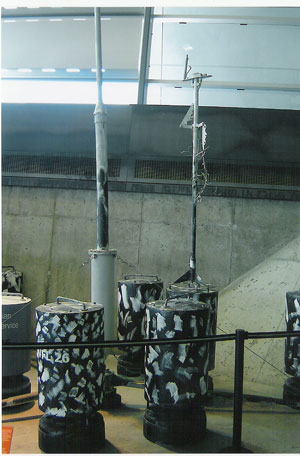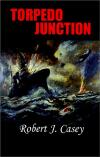Special Operations
Weather station Kurt erected in Labrador in 1943
The U-537 made the only armed German landing on North American soil in WWII.
U-537 left Kiel, Germany on September 18, 1943. She made a brief stop in Bergen, Norway and headed out to sea again on 30 Sept. The boat went on patrol in the western North Atlantic under Kptlt. Peter Schrewe. Its task was to set up an automatic weather station on the coast of Labrador. U-537 carried a scientist, Dr. Kurt Sommermeyer, and Wetter-Funkgerät (WFL) number 26 (the sixth in a series of 21 such stations) manufactured by Siemens. It consisted of various measuring instruments, a 150-watt Lorenz 150 FK-.type transmitter and ten canisters with nickel-cadmium and dry-cell high-voltage batteries.
On October 22 U-537 arrived at Martin Bay at the northern tip of Labrador. For the next 48 hours U-537 lay at anchor while the crew manhandled the 220-pound canisters, along with a tripod and mast, into rubber boats and then onshore. The weather station was set up 400 yards inland on a 170 feet high hill. At 5:40 P.M. on October 23, having ensured that the station was functioning properly, Schrewe weighed anchor and set off for an anti-shipping patrol off Newfoundland. His patrol was uneventful and on December 8 U-537 returned to Lorient, France.
Reports indicate that the weather station sent out normal transmissions for a few days, but then there was apparent jamming on that frequency (about which nothing is known; no evidence has yet turned up that the Allies learned about the equipment).
U-537 was transferred to the Far East and sunk with all hands on board in late 1944 - only Dr. Sommermeyer and crew member, who had left the boat prior to the its transfer to the Far East, survived the war.
The station remained unknown until ...
Thus the station was a secret known only by a handful German seamen and scientists. The story became known in the late 1970s, when an engineer named Franz Selinger after his retirement from Siemens decided to write a history of the German weather service. Among Dr. Sommermeyer's papers he found photographs of one weather station and a U-boat that did not fit in with the eastern Arctic installations he had previously been able to identify (Greenland and Svalbard). He identified the Labrador coast, but neither Canadian nor American authorities could provide evidence. Via Jürgen Rohwer and the son of Dr. Sommermeyer he then identified the U-537 and located the logbook at the archives in Freiburg.
In 1980 he wrote to the official historian of the Canadian armed forces, W.A.B. Douglas (who has written an article in MHQ). Douglas and the Canadian Coast Guards were able to go and look and actually found the remains of the weather station. Some parts were missing, but the canisters, tripod and mast, and some dry-cell batteries was left to identify.
The current location of weather station Kurt

Kurt as displayed at the Canadian War Museum, Ottawa.
After the rediscovery of the station in the 1980s by the Canadian Coast Guard (following press articles etc. on the subject), it was dismantled and brought to the Canadian War Museum in Ottawa. This unique historical artefact from the war is now on permanent, public display (see photo) at the Canadian War Museum.
Interesting page on Kurt
This link includes photos of the crew of U-537 at Labrador plus a nice write-up of the operation.
Heritage Daily. Nazi Weather Station Kurt
Another weather station in Labrador planned
In July 1944, the U-867 reportedly set out from Norway to erect a second weather station in Labrador but was sunk en route by RAF planes.
Special thanks to Peter Hvidtfeldt.



